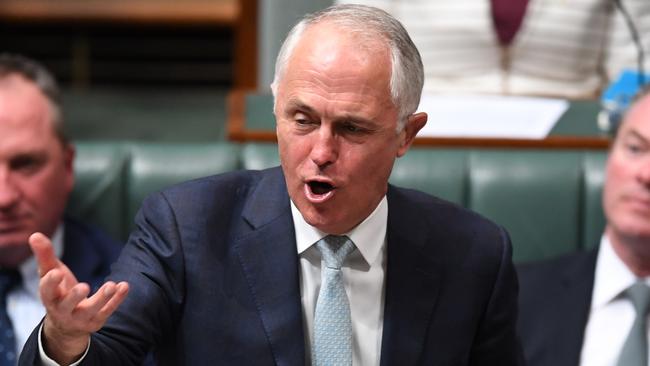Turnbull’s AGL power deal averts shortfall after Liddell closure
Malcolm Turnbull has struck a deal with power giant AGL to prevent a looming energy shortage.

Malcolm Turnbull has struck a deal with power giant AGL to prevent a looming energy shortage by extending the life of a vital coal-fired power station for five years, unless the company drafts a plan within 90 days to install new generators to take its place.
The Prime Minister ended a meeting with AGL chief executive Andy Vesey with a commitment from the company to avoid the forecast market shortfall that is fuelling fears of higher prices and potential blackouts when the company closes its Liddell coal power station.
Judith Sloan comments: How AGL is having its cake and eating it
The Prime Minister will come under increasing pressure to decide whether to embrace a clean energy target across the electricity sector, given Mr Vesey’s public call for the government to “set the rules” so the industry can plan investments in new power.
The AGL board will consider plans to install gas-fired power stations to replace Liddell but the government said the outcome would have to ensure “no adverse impact on consumers” in price and reliability.
The agreement is a significant win for the government in the escalating political dispute over energy, after Labor complained that the idea of extending the life of Liddell was only a “thought bubble” that gave “false hope” to workers.
While Mr Vesey has vowed to “get out” of coal, the company expects to keep its Bayswater and Loy Yang coal-fired power stations running until the 2040s.
Coal power accounted for $1.54 billion, or almost 80 per cent, of AGL’s earnings from its wholesale electricity business last year.
AGL did not ask for federal aid to keep Liddell operating but has previously warned that it was exposed to policy decisions in Canberra — such as the clean energy target that is dividing the Coalition — that would shape the economic viability of its investments.
Yesterday’s talks followed a warning from the Australian Energy Market Operator last week on the need to develop at least 1000 megawatts of new electricity capacity by 2022 to make up for the scheduled closure of the NSW power station.
Mr Vesey said the company had committed to deliver a plan in 90 days to avoid the market shortfall, but he made it clear that he could proceed with the closure of Liddell if the company invested in alternative forms of generation.
“I was asked to take to the AGL board the government’s request to continue the operation of Liddell post-2022 for five years and/or sell Liddell, which I agreed to do,” he said in a statement.
Mr Vesey said the likely replacement for coal-fired power would be gas power, pumped hydro, batteries or “load-shaping” to reduce demand.
His comments were a clear repudiation of Coalition MPs’ claims that the government should back the construction of a new coal power station.
“We just don’t see new development of coal as economically rational, even before factoring in a carbon cost,” Mr Vesey said. The company has outlined investments in new power generation worth about $2.2bn but none of this is coal-fired, with about $1.4bn going to wind generation and the rest on gas projects.
Energy Minister Josh Frydenberg said AGL had asked for 90 days to prepare the work on new options. “The outcome of the meeting is that AGL will take to its board a proposal to keep Liddell open for another five years or to sell to another party,” he said.
“At the same time, the company will work up a plan to ensure sufficient additional supply into the market equivalent to what is coming out of Liddell. This would be firm dispatchable capacity and have no adverse impact on consumers both in terms of price and the reliability of the system.”
Asked whether AGL requested financial assistance, Mr Frydenberg said: “That was not the discussion today. They did not ask for that support from the commonwealth.” AGL had also not asked for a clean energy target during the discussions, given that was not the reason for the talks.
The 90-day period could set a deadline for a decision on the clean energy target, despite huge divisions within the Coalition on whether to embrace the idea recommended by Chief Scientist Alan Finkel in a report in June.
Mr Vesey said last month the government should adopt his recommendations in their entirety and “set the rules” for future investment.
Labor energy spokesman Mark Butler has dismissed the idea of extending the life of the Liddell power station while Greens senator Sarah Hanson-Young yesterday warned that it could cost $1bn to refurbish the plant.
AGL has put a figure of $898 million on the rehabilitation of its NSW coal-fired power stations but this is for both Liddell and Bayswater. The closure of the latter is more than two decades away.
Liddell had a forced outage rate of 46.1 per cent when AGL bought it and the nearby Bayswater power station from the NSW government in 2014. It remains unreliable, with two of its four units failing during a heatwave in February.
Even so, it has a capacity of 1680MW and generates enough electricity to power more than one million homes — raising the question of whether it is more attractive to extend its life beyond 2022 while planning and building new gas-fired generators. A key factor in the decision will be the long-term outlook for gas prices, with the government moving within months to curb exports of liquefied natural gas to boost supplies to power generators.
The Prime Minister blamed Labor for failed to act on the gas problem when it was in power in 2012, when the Gillard government’s energy white paper said there was no need for export controls.



To join the conversation, please log in. Don't have an account? Register
Join the conversation, you are commenting as Logout